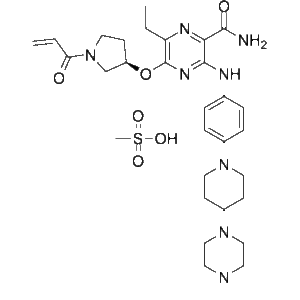Naquotinib mesylate
This product is for research use only, not for human use. We do not sell to patients.

For small sizes, please check our retail website as below: www.invivochem.com
| Size | Price | Stock |
|---|---|---|
| 100mg | $850 | To Be Confirmed |
| 250mg | $1600 | To Be Confirmed |
| 500mg | $2400 | To Be Confirmed |
Cat #: V26243 CAS #: 1448237-05-5 Purity ≥ 99%
Description: Naquotinib mesylate (ASP-8273; ASP8273), the mesylate salt of Naquotinib, is an irreversible/covalent and third-generation epidermal growth factor receptor (EGFR) inhibitor with potential anticancer activity.
Top Publications Citing Invivochem Products
Publications Citing InvivoChem Products
Product Promise

- Physicochemical and Storage Information
- Protocol
- Related Biological Data
- Stock Solution Preparation
- Quality Control Documentation
| Molecular Weight (MW) | 658.81 |
|---|---|
| Molecular Formula | C31H46N8O6S |
| CAS No. | 1448237-05-5 |
| SMILES Code | O=C(C1=NC(CC)=C(O[C@H]2CN(C(C=C)=O)CC2)N=C1NC3=CC=C(N4CCC(N5CCN(C)CC5)CC4)C=C3)N.CS(=O)(O)=O |
| Synonyms | ASP8273; ASP-8273; ASP 8273; ASP8273 mesilate; Naquotinib mesylate |
| Protocol | In Vitro | In assays using endogenously EGFR-dependent cells, Naquotinib inhibits the growth of PC-9(del ex19), HCC827(del ex19), NCI-H1975(del ex19/T790M) and PC-9ER(del ex19/T790M) with IC50s of 8-33 nM. |
|---|---|---|
| In Vivo | Oral Naquotinib treatment dose dependently induces tumor regression in NCI-H1975 (L858R/T790M), HCC827 (del ex19) and PC-9 (del ex19) xenograft models. Dosing schedules does not affect the efficacy of Naquotinib. In an NCI-H1975 xenograft model, complete regression of tumor is achieved after 14-days of Naquotinib treatment. Complete regression is maintained in 50% of mice more than 85 days after cessation of Naquotinib treatment. |
These protocols are for reference only. InvivoChem does not
independently validate these methods.
| Solvent volume to be added | Mass (the weight of a compound) | |||
|---|---|---|---|---|
| Mother liquor concentration | 1mg | 5mg | 10mg | 20mg |
| 1mM | 1.5179 mL | 7.5894 mL | 15.1789 mL | 30.3578 mL |
| 5mM | 0.3036 mL | 1.5179 mL | 3.0358 mL | 6.0716 mL |
| 10mM | 0.1518 mL | 0.7589 mL | 1.5179 mL | 3.0358 mL |
| 20mM | 0.0759 mL | 0.3795 mL | 0.7589 mL | 1.5179 mL |
The molarity calculator equation
Mass(g) = Concentration(mol/L) × Volume(L) × Molecular Weight(g/mol)
Mass
=
Concentration
×
Volume
×
Molecular Weight*
The dilution calculator equation
Concentration(start)
×
Volume(start)
=
Concentration(final)
×
Volume(final)
This equation is commonly abbreviated as: C1 V1 = C2 V2
Concentration(start)
C1
×
Volume(start)
V1
=
Concentration(final)
C2
×
Volume(final)
V2
Step One: Enter information below
Dosage mg/kg
Average weight of animals g
Dosing volume per animal µL
Number of animals
Step Two: Enter the in vivo formulation
%DMSO
+
%
+
%Tween 80
+
%ddH2O
Calculation Results:
Working concentration:
mg/ml;
Method for preparing DMSO master liquid:
mg
drug pre-dissolved in
µL
DMSO(Master liquid concentration
mg/mL)
,Please contact us first if the concentration exceeds the DMSO solubility of the batch of drug.
Method for preparing in vivo formulation:
Take
µL
DMSO master liquid, next add
µL
PEG300, mix and clarify, next add
µL
Tween 80,mix and clarify, next add
µL
ddH2O,mix and clarify.
Note:
- (1) Please be sure that the solution is clear before the addition of next solvent. Dissolution methods like vortex, ultrasound or warming and heat may be used to aid dissolving.
- (2) Be sure to add the solvent(s) in order.




































